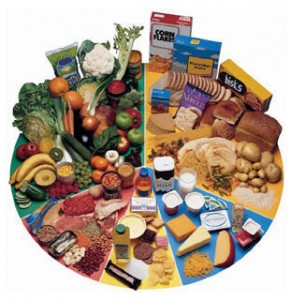 I was trying to rack my brains about what to write about first, trying to think what issues were most important to youth athletes. Then it occurred to me that even my Dad doesn’t know that chicken is mainly a source of protein (not carbohydrate as he suggested!), so I thought it was a good idea to start with the basics.
I was trying to rack my brains about what to write about first, trying to think what issues were most important to youth athletes. Then it occurred to me that even my Dad doesn’t know that chicken is mainly a source of protein (not carbohydrate as he suggested!), so I thought it was a good idea to start with the basics.
Therefore, the idea of this first blog is to introduce you to the 6 main nutrient categories in our balanced diets (Carbohydrate, Protein, Fats, Water, Vitamins and Minerals) and what foods are good sources of each. From there you will all be on the same page and hopefully have a greater understanding of my forthcoming blogs.
Carbohydrate: the largest provider of energy in your body
Carbohydrate is easily converted into energy in our bodies and used to fuel our muscles during physical activity, such as rugby. It is also used to fuel other organs such as the brain. In fact, it is the primary source of energy that powers the brain, so a low carbohydrate intake can not only make us feel tired but may also lead to poorer decision-making too!
Two categories of carbohydrate that you may have heard people refer to are complex and simple carbohydrates. However, these categories are mostly based on their chemical structure, so lets not even go there! Another way to categorise carbohydrates, which is perhaps more relevant to you, is through something called glycemic index. Don’t let the name put you off, I will explain this as clearly as I can.
When the carbohydrates we eat enter the digestive system in our bodies, they are broken down into smaller “bits”. These bits are sugars (you may have heard of ones called glucose or fructose). When the body has finished breaking the larger carbohydrates down into these smaller sugar molecules they can be absorbed into our blood. Now this is where “glycemic index” comes into play. The glycemic index (“GI”) is simply a measure of the speed at which glucose is released into our blood stream (i.e. how quickly it is digested and absorbed after we have eaten it!).
So why would this matter to you!?
If you eat foods that release sugars quickly into your bloodstream (i.e. ones that are named high glycemic index carbohydrates) you will be able to use this energy more readily – they will give you the fuel you need to power your muscles soon after eating them.
I know you will probably be thinking that this is therefore the best form to have, but for some of us (me included!), who get slightly nervous before a match or a competition, it is often quite difficult to eat soon before. Having low glycemic index carbohydrates a few hours before results in sugars being released into your bloodstream for a more prolonged period – meaning that you will still get some fuel a few hours down the line.
It’s all well and good me telling you about these high and low glycemic index carbohydrates, but I am sure you are wondering where you can find such food sources. Well, it is generally easy to remember that food with a lower glycaemic index tend to be the less refined foods such as wholemeal pasta, wholemeal bread and porridge (they are also foods that tend to be high in fibre – not so good for the nerves!)
Foods with a higher GI tend to be more refined such as white bread and pasta, and also both natural (fruits, honey) and more processed (sweets, flapjacks, sports drinks) sugary foods.
Protein: the building block
Protein is the building block for your muscles, and in fact for life. Besides water (and potentially fat), protein is one of the most abundant components of our body. For example, around half of the volume of our bones is protein.
As rugby players, protein is a vital component of your diet. It plays an important role in the muscle-building and repair – whether it is building muscle to become lean or repairing any muscle tissue that is damaged through the activity they do.
Protein can be found in large amounts in meat, beans, fish, dairy, eggs and nuts. High quality proteins can also be found in some sports nutrition products such as whey protein powders.
Fats: not all bad
Yes, if you eat 10 packets of crisps a day, 5 packets of sweets and a chocolate fountain your intake of saturated fat may be detrimental to your health, and of course you may put on a few pounds! However, I am sure you have heard of the saying that “not all fats are bad”. Fat is actually a central component to the cells in our body. It is also needed for energy when you run long distances or do low intensity physical activity. So, eating them in moderation is actually a good thing – it just depends on which type!
There are 2 main types of fats you should be aware of – saturated and unsaturated.
Saturated fats can be found in foods containing animal fats (e.g. meat, butter, cheese, cream) and also in those yummy treats like savoury snacks (i.e. crisps, pastry to name a few) and confectionary (e.g. chocolate, biscuits, cakes etc). We should have foods containing high levels of saturated fat in moderation.
Unsaturated fats are a good source of the essential fatty acids. This is simply fat that our body needs in the diet because it cannot make it internally. These can be found in oily fish, nuts, avocados and olive oils.
Water: the most abundant component of our bodies
For the body to work, it needs water – simple! Our bodies are made up of 70% water. Therefore, it is important to stay hydrated. When we exercise we lose water in the form of sweat, so it is even more important to focus on your fluid intake, especially as dehydration can negatively impact performance. So, remember to take plenty of fluid on board and bear in mind that food has water in it too. Foods such as cucumber, celery, melons and tomatoes are just a few examples of foods with high water content.
A tip on how to stay hydrated – the pee test! Although a few foods can slightly effect the colour of our urine, the “pee test” is a simple test to do in order to test how hydrated we are. Just keep an eye on the colour of your urine, if it is dark yellow / orange then you may need a little more water. Another rough guide is how often you “go” – if you have a lot of trips to the toilet it may be that you are drinking more than you need!
Vitamins and Minerals: Small yet significant
These nutrient categories are called “micronutrients”. As the name suggests (the word “micro” meaning “littl”e), we only need them in small amounts in our diet. However, just because we need them in small amounts doesn’t mean they don’t play an important role in our bodies. Just think, even the smallest piece of scaffolding is essential to maintain its structure and function!
Vitamins have many important roles in the body; an important one for you is fighting against infection. They play a key role in our body’s immune system. Vitamins can be found in high amounts in fruit and vegetables – so keep up your 5-A-day!
Minerals are substances such as potassium, sodium, calcium and iron. All of these are essential to the efficient functioning of our body. Each one has a specific function, for example calcium helps your bones grow and develop and iron helps your blood transport oxygen. Food sources of these minerals vary depending on each mineral but fruit, vegetables, nuts, bread, meat, fish and dairy foods contain sources of certain minerals.
Some vitamins (e.g. vitamin C and E) and minerals (e.g. Zinc) also play a role as antioxidants. One role of antioxidants specific to you is that they help to prevent damage to our cells when we exercise.
So make sure you have a balanced diet with plenty of fruit and vegetables and you will be sure to get enough of these small but significant nutrients!
I think that is enough to take in for now, I hope you have found this helpful – all feedback welcome!
Happy eating,
Sophie








 When most people hear the word “Peloton” they think of an expensive black bike with shiny red buttons and that controversial commercial where the husband gifted his wife a Peloton for Christmas.
When most people hear the word “Peloton” they think of an expensive black bike with shiny red buttons and that controversial commercial where the husband gifted his wife a Peloton for Christmas. If the app interests you, Peloton is currently offering a 30 day FREE TRIAL, so why not give it a try? Check it out
If the app interests you, Peloton is currently offering a 30 day FREE TRIAL, so why not give it a try? Check it out 

 This article would not be complete, however, if we did not acknowledge some of the delivery issues that have been plaguing Peloton over the last year. Most of the delivery issues seem to affect U.S. deliveries, however, the UK deliveries have been affected as well.
This article would not be complete, however, if we did not acknowledge some of the delivery issues that have been plaguing Peloton over the last year. Most of the delivery issues seem to affect U.S. deliveries, however, the UK deliveries have been affected as well.








2 Comments to Rugby Nutrition: The Basics